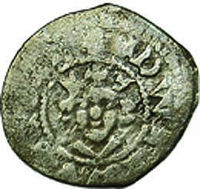020 7636 1188 info [at] coincraft.com
You have no items in your shopping cart.
English Hammered Coins
View as
Sort by
Display per page
Filter by attributes
- Pre-Decimal Denomination
- Farthing
- Penny
- Sixpence (Tanner)
- Shilling (Bob)
- Crown
Charles I, Crown, Tower Mint Group III Type 3a m.m. Fine/Very Fine
(over Bell reverse). Third horseman, rev: oval shield without CR. S2758. Weak spot to the obverse, otherwise F/VF. A respectable example of this wonderful large Crown.
£2,250.00
Edward I, Farthing Fine
The farthing marked the start of a revolutionary coinage reform by Edward I. Until this time, the penny was the smallest denomination. Low value transactions could be conducted using pennies cut into halves or quarters. The act of cutting pennies into quarters or fourths was how the word Farthing or “fourthing” came about. These silver farthings were introduced by Edward I during the recoinage of 1279. They brought about the end of the practice of cutting coins into halves and quarters. The old coinage and the use of pennies cut into farthings remained legal tender until they were demonitised in August 1280. These coins were the smallest silver coins of the early medieval period and were well circulated and are now over 700 years old, and they are much scarcer than the Pennies. We have been putting these aside for many years and are delighted to offer them to you now, for the first time. Available in Fine, while stocks last.
£99.50
Edward I, Farthing VG
The farthing marked the start of a revolutionary coinage reform by Edward I. Until this time, the penny was the smallest denomination. Low value transactions could be conducted using pennies cut into halves or quarters. The act of cutting pennies into quarters or fourths was how the word Farthing or “fourthing” came about. These silver farthings were introduced by Edward I during the recoinage of 1279. They brought about the end of the practice of cutting coins into halves and quarters. The old coinage and the use of pennies cut into farthings remained legal tender until they were demonitised in August 1280. These coins were the smallest silver coins of the early medieval period and were well circulated and are now over 700 years old, and they are much scarcer than the Pennies.
£74.50
Edward I, Penny (Bristol Mint) Fine
In the reign of Edward I, the Silver Penny was the largest denomination made for circulation. Here we offer examples of the Edward I Silver Penny from the Bristol Mint in Fine condition.
£149.50
Edward I, Penny (Bristol Mint) Very Good
In the reign of Edward I, the Silver Penny was the largest denomination made for circulation. Here we offer an example of an Edward I Silver Penny from the Bristol Mint in Very Good condition.
£95.00
Edward I, Penny (Bury Mint) Fine
In the reign of Edward I, the Silver Penny was the largest denomination made for circulation. Here we offer an Edward I Silver Penny from the Bury Mint in Fine condition.
£139.50































